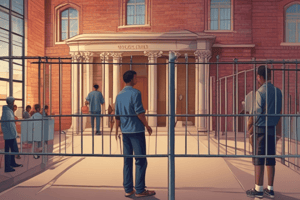Podcast
Questions and Answers
What does 'commitment' mean in juvenile justice?
What does 'commitment' mean in juvenile justice?
- A judge puts the juvenile in the custody of a state correctional authority (correct)
- A juvenile is placed in a foster home
- A juvenile is freed from custody
- A juvenile is sent home
What is the role of the juvenile justice administrative body?
What is the role of the juvenile justice administrative body?
Responsible for the administration and management of juvenile justice placements within a state.
Juvenile placement in secure facilities is increasing.
Juvenile placement in secure facilities is increasing.
False (B)
Which states combined represent 44% of all juveniles in custody in the US?
Which states combined represent 44% of all juveniles in custody in the US?
What percentage of the population in private facilities is held under delinquency offenses?
What percentage of the population in private facilities is held under delinquency offenses?
What is primarily focused on in juvenile boot camps?
What is primarily focused on in juvenile boot camps?
What are the four primary goals in corrections?
What are the four primary goals in corrections?
Juvenile detention facilities are designed to house juveniles awaiting __________ or __________.
Juvenile detention facilities are designed to house juveniles awaiting __________ or __________.
What kind of atmosphere do youth ranches and camps typically have?
What kind of atmosphere do youth ranches and camps typically have?
Incapacitation means providing juveniles with education.
Incapacitation means providing juveniles with education.
What do public surveys reveal about the belief in rehabilitation for juvenile offenders?
What do public surveys reveal about the belief in rehabilitation for juvenile offenders?
According to public surveys, where do respondents believe government funds should be shifted?
According to public surveys, where do respondents believe government funds should be shifted?
What is the main challenge faced by educators in juvenile facilities?
What is the main challenge faced by educators in juvenile facilities?
What principles does the educational model by the Office of Juvenile Justice recommend?
What principles does the educational model by the Office of Juvenile Justice recommend?
What percentage of delinquents aged 16 and older do not return to school after release?
What percentage of delinquents aged 16 and older do not return to school after release?
Specialized treatment programs include services for youths with learning disabilities.
Specialized treatment programs include services for youths with learning disabilities.
What common features characterize programs for serious youth?
What common features characterize programs for serious youth?
How do juveniles typically respond to institutional life?
How do juveniles typically respond to institutional life?
Juveniles have no difficulty adjusting to the structured life in a facility.
Juveniles have no difficulty adjusting to the structured life in a facility.
What implication does juvenile suicide during incarceration have?
What implication does juvenile suicide during incarceration have?
What is a significant issue regarding working in institutional corrections?
What is a significant issue regarding working in institutional corrections?
What percentage of youth in juvenile facilities experience some kind of sexual victimization?
What percentage of youth in juvenile facilities experience some kind of sexual victimization?
Flashcards are hidden until you start studying
Study Notes
Commitment
- A commitment order by a juvenile court judge places a juvenile in state correctional custody or a specific facility.
Juvenile Justice Administrative Body
- This organization is charged with managing juvenile justice placements in a state.
Juvenile Placement Info
- Secure placements for juveniles can occur due to pre-adjudication detention, court commitments, or placements by administrative bodies.
- A significant drop in juvenile secure facility populations contrasts with rising juvenile arrest rates.
- More juveniles are incarcerated for less serious offenses, reflecting changes in drug policy and a shift toward intervention over incarceration.
- There's a growing trend toward individualized services for smaller offender groups rather than large-scale incarceration due to concerns about abuse and re-offending.
Population in Institutional Corrections
- Only a small fraction of arrested juveniles are committed to residential placements.
- Six states (CA, TX, PA, NY, OH, FL) account for 44% of all juvenile placements.
- State correctional authorities oversee juvenile facility operations, deciding placement and treatment plans.
- Most juvenile populations in secure facilities consist of young males convicted of serious or multiple offenses.
Private Facilities
- Operated by private corporations or individuals, these facilities serve juvenile offenders.
Public vs. Private Facilities
- The juvenile system includes public facilities held under court orders, with private facilities accommodating a higher percentage of status offenders and youths with emotional disturbances.
State Variables with Private Facilities
- Significant state variations exist in custody rates and the use of private facilities, influenced by age jurisdiction, transfer laws, demographic factors, and facility capacity.
Institutional Facilities
- Include various secure settings such as detention centers, assessment centers, and youth camps, catering to detained and committed juveniles.
Institutional Facilities for Juveniles
- Institutions serve juveniles awaiting hearings or committed by courts, involving various placements based on offenses and treatment needs.
Juvenile Detention Facilities
- Secure brief-term facilities for youths awaiting court hearings, distinct from adult jails, which house sentenced criminals.
Detention Info
- Detention centers increased juvenile holding rates by 29% from 1985-2009, with a noted rise in females and black youth in detention populations.
Assessment Facility
- Secure centers conduct orientations and assessments for committed juveniles, creating profiles for appropriate placements.
Transfer or Transitional Facilities
- Temporary homes for juveniles awaiting transfer or community release, with minimal programming for those transitioning back into society.
Juvenile Boot Camp
- Military-style correctional facilities emphasizing discipline, starting in 1983 with about 75 camps by the 1990s, although evaluations highlight systemic issues.
Three Boot Camps
- Demonstration camps in Cleveland, Denver, and Mobile aimed to evaluate boot camp effectiveness but found no significant reduction in recidivism rates.
Youth Ranches and Camps
- These facilities provide a camp-like environment with vocational training and rehabilitation through active participation in agricultural or adventure programs.
State Institutions and Schools
- Comprehensive facilities offering varied rehabilitation services, now shifting towards smaller community-based models since the 70s.
Programming in Institutional Corrections
- Treatment plans in juvenile institutions aim to alter behaviors, focusing on rehabilitation rather than incarceration.
Rehabilitation
- Methods strive to reform juvenile offenders for productive reentry into society.
Deterrence
- Structured conditions in law aim to make juveniles aware of risks and consequences of crime.
Incapacitation
- Removing juveniles from communities prevents further criminal behavior.
Correctional Treatment Info
- Juvenile institutions emphasize rehabilitation and have distinct treatment methods, focusing more on rehabilitative efforts than adult prisons.
Correctional Education Info
- Education in secure facilities is critical as many juveniles are below expected levels academically; teachers must integrate treatment plans into instruction.
Education Model by the Office of Juvenile Justice
- The model emphasizes an enhanced curriculum involving problem-solving, skill integration, and collaborative learning.### Instructional Strategies in Education
- Cognitive processes are modeled through diverse instructional strategies.
- Emphasis on externalizing thought processes and multiple problem-solving approaches.
- Dialog and reciprocal learning are crucial for student engagement.
Assessment and Evaluation Measures
- Progress is evaluated using a variety of assessment tools.
- Focus on mutually defined student goals to promote competence.
Instructional Adaptability
- Instruction employs varied strategies tailored to each learner's needs and interests.
- Integration of reading, writing, and oral expression as interrelated skills.
Correctional Industry and Vocational Training
- Majority of delinquents aged 16+ do not return to school post-release.
- Training emphasizes teamwork, information acquisition, system understanding, and technology use.
- Facilities may offer internships, apprenticeships, and mentorships to enhance employability.
- CA Division of Juvenile Justice's Free Venture Program allows businesses to operate within correctional settings.
- Inmates receive wages subject to deductions including taxes, room and board, restitution, family support, and savings.
Specialized Treatment and Programs
- Designated programs for capital offenders, sex offenders, and youths with emotional disturbances.
- Approximately 40% of incarcerated youths may have a learning disability.
- Special education focuses on needs assessment, tailored curriculum, vocational training, and transitional services.
- Programs aim to enhance cognitive and social skills for successful societal reintegration.
Programs for Serious and Repeat Juvenile Delinquents
- Serious offenders commit violent crimes with significant societal impact.
- First-time serious offenders often receive secure placements regardless of background.
- TX Juvenile Justice Dept. runs programs for serious offenders, including crime reenactments.
- Lighthouse Youth Center in Ohio offers specialized programs for serious felonies.
Key Features of Lighthouse Youth Center
- Utilizes a Problem Oriented Record System (PORS) for individualized intervention.
- Implements a peer booking system and personality-based classification.
- Employs a structured program phase pattern and team-based management.
- Includes a family program and intensive aftercare supervision.
Common Characteristics of Serious Youth Programs
- Programs feature defined treatment goals and strong intuitive appeal.
- Treatment plans demonstrate positive effects and lower recidivism compared to simple incarceration.
- Enjoy strong support from judges and administrators and often serve a limited number of youths.
Institutional Life for Juveniles
- Adjustment to juvenile facilities varies based on personality and prior history.
- Smaller inmate populations and structured interactions ease transitions into facilities.
Facility Life Challenges
- Juveniles struggle to adapt to strict schedules and emotional, social, and psychological challenges.
- Counseling, educational, recreational, and vocational programs are crucial for rehabilitation.
- Post-release transition can be challenging due to ingrained institutional behaviors.
Suicide in Juvenile Corrections
- Despite low statistical occurrence, implications for treatment are significant.
- Most suicides occur after 75 days of detention; victims often white males around 15.7 years of age.
- Majority confined for nonviolent offenses, with hanging being the common method.
Sexual Abuse in Juvenile Facilities
- Sexual victimization is a notable concern, affecting 12% of youth in various facilities.
- Male youths often face abuse from staff, while females report interactions with peers.
Working in Institutional Corrections
- Large juvenile facilities operate like small cities, requiring diverse staffing roles.
- Training and retention of qualified personnel pose significant challenges.
- Demographics of juvenile correctional staff differ from those working in adult prisons.
Studying That Suits You
Use AI to generate personalized quizzes and flashcards to suit your learning preferences.




